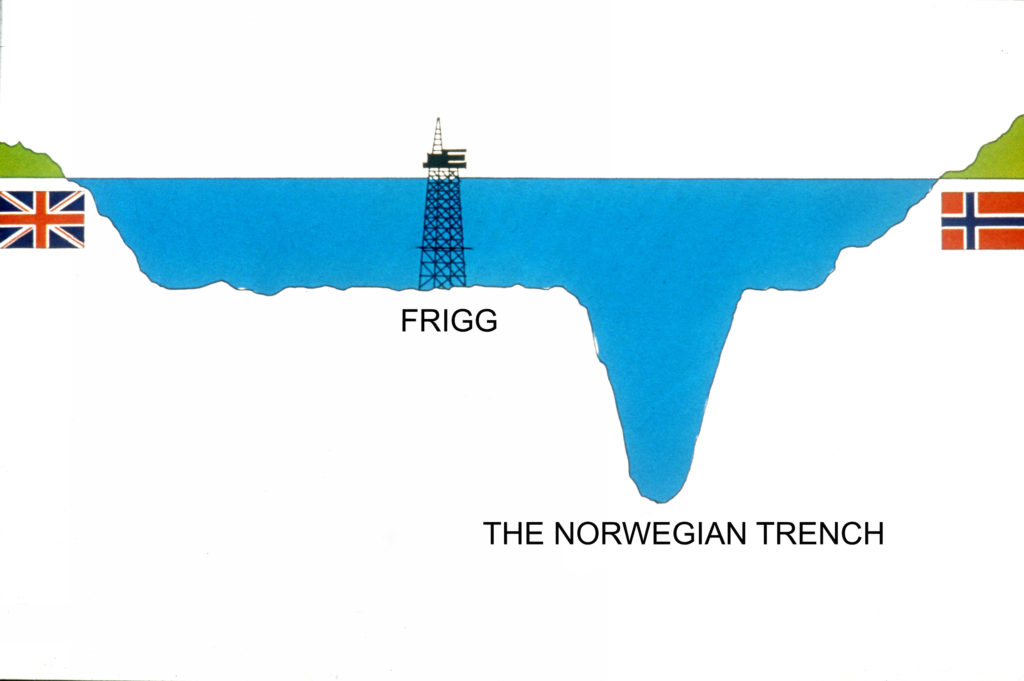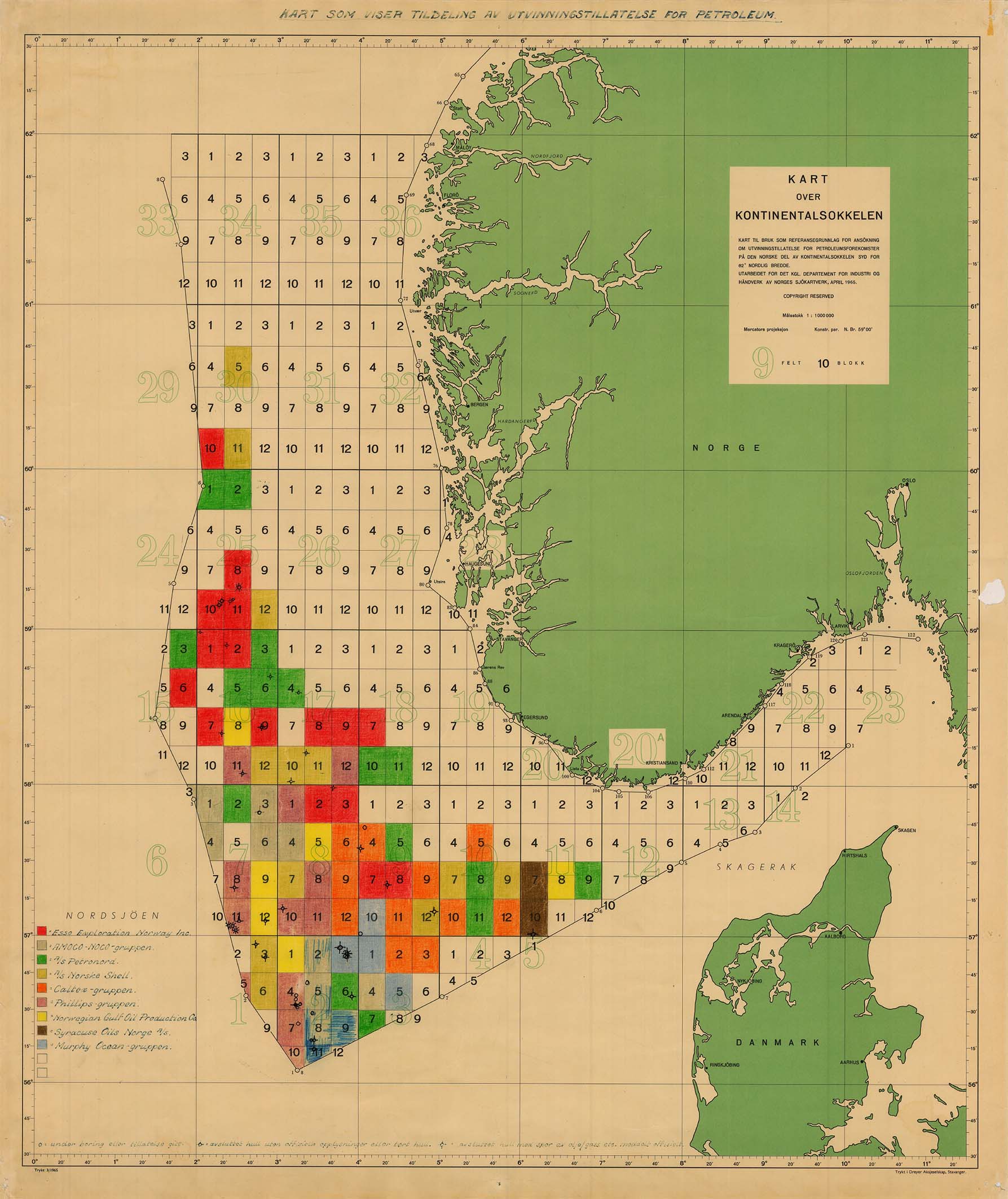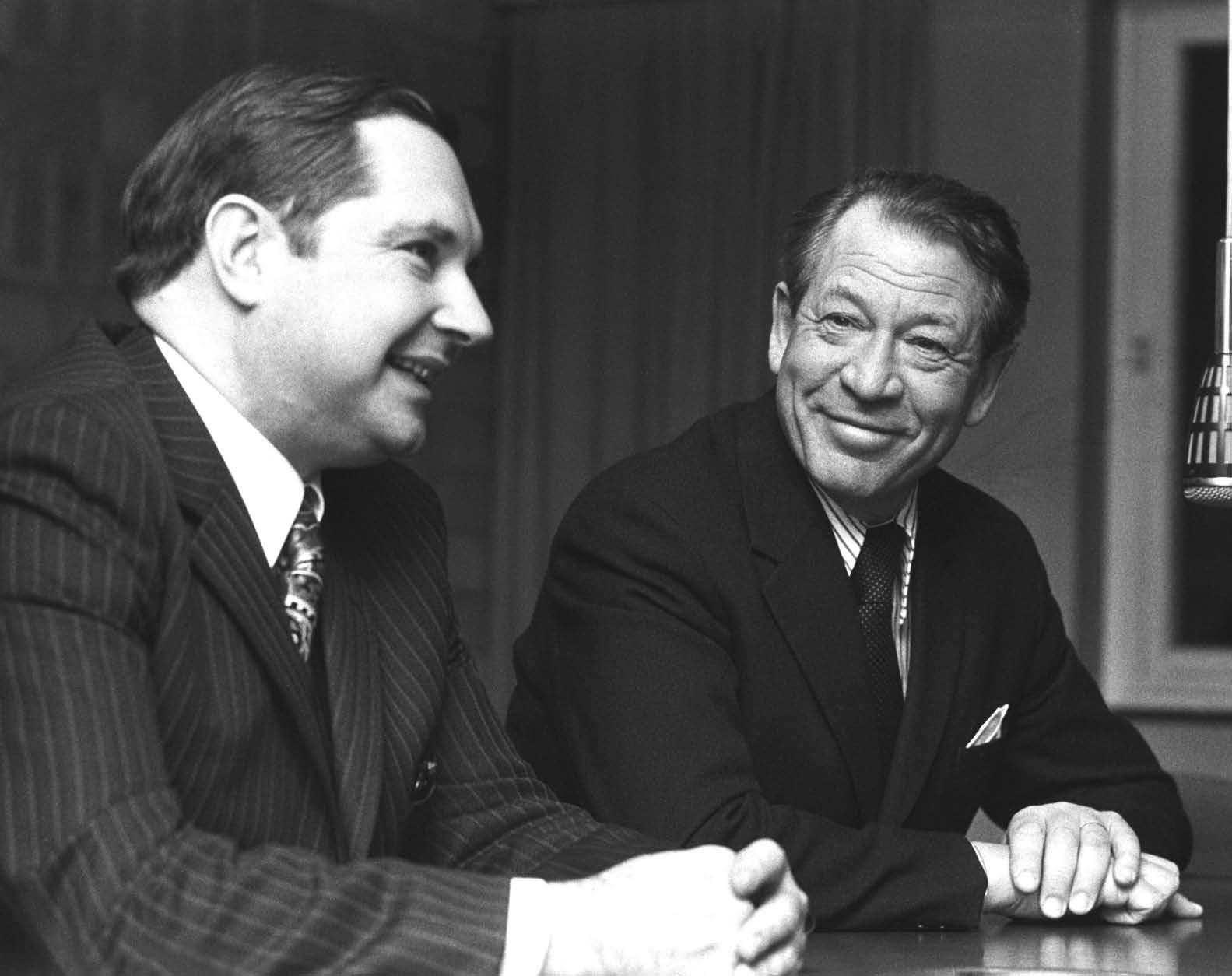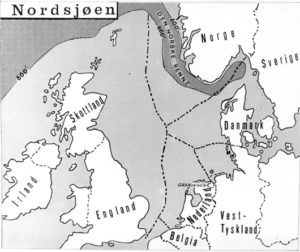Could Valhall have been Danish?

A boundary with the UK had only been approved the previous June. It was based on the median line, and the Norwegian expectation was that this principle would also be applied with the Danes. Since the talks had still to be concluded, however, the blocks closest to the temporary border – which included Hod and parts of Valhall – were excluded from Norway’s first offshore licensing round. This acreage was not awarded until 1968. The question is whether a possibility ever existed during the negotiations, which began in 1964 and were concluded on 8 December 1995, that Valhall and Hod – and Ekofisk too, for that matter – could have ended up on the Danish side of the boundary?
Myths and facts
A controversial myth has persisted that Ekofisk could have gone to Denmark if the Danish Social Democratic foreign minister of the day, Per Hækkerup (1915–75, foreign minister, 1962–66) had stayed sober during the negotiations with his Norwegian opposite number, Halvard Lange.[REMOVE]Fotnote: Dag Schartum’s archive at the Norwegian Petroleum Museum: Letter to Amoco Norway Oil Company from the Ministry of Industry, 17 August 1965, with information on production licences.
Legend has it that Hækkerup had drunk too much whisky and thereby become overly generous with the Norwegians, who accordingly ended up with the area containing Ekofisk. He thereby deprived his fellow Danes of substantial revenues. This fable gained currency and an almost semi-official status in 1992, when it was repeated by Danish historian Tage Kaarsted in De Danske Ministerier , the big standard work on the Danish cabinets. But the story is and will remain a myth, although it cannot be denied that Hækkerup was drunk in Oslo. He is not known for an aversion to spirits, according to the website for the University of Århus.[REMOVE]Fotnote: dkhist@hum.au.dk “Myte: Forærede Hækkerup Nordsøolien væk pga. fuldskab?”
 Kunne Valhall vært dansk?, økonomi og samfunn,
Kunne Valhall vært dansk?, økonomi og samfunn,A map of the boundaries finally agreed between continental shelf areas in the North Sea. The grey zone indicates how they might have looked if the Norwegian Trench ( Norskerennen) undersea valley had not been defined as a chance depression in the seabed. The pink dotted lines shows how the German boundary would have looked if the median line principle had been applied when determining its continental shelf. However, the International Court of Justice in The Hague chose to apply a reasonable and just test in this case.
Another rumour about the boundary negotiations, which is not so well known, alleges that Sweden sought to obtain a sector in the Skagerrak and may thereby have delayed the talks between Norway and Denmark.[REMOVE]Fotnote: Dag Schartum’s archive at the Norwegian Petroleum Museum: Memo of 10 September 1965 by B W Bommen. The truth of this story has not been verified.
A third – and factual – consideration is that the boundary line negotiations were pursued by Norway with both Denmark and the UK on the basis of the Geneva convention on the continental shelf of 1958. This enshrined the median line principle, but also specified that a coastal state’s jurisdiction over the seabed only as far as a water depth of 200 metres. That was no problem in the Danish case, since the seabed off its coasts is 30-50 metres deep. But a deepwater depression runs close to land off Norway’s south-west coast. This Norwegian Trench descends to 300-400 metres at its deepest.
Theoretically, the Norwegian continental shelf could have terminated on the landward slope of this feature, with the remainder – including Ekofisk, Valhall, Hod and much more – falling to Denmark. But Norway and the UK had reached agreement in their negotiations that the Trench should be regarded as a chance depression in the seabed, and divided their sectors in accordance with the median line principle. Since the Danes also sought to apply this principle in their negotiations with the Germany, it was not easy for them to demand that another approach should be taken in regard to Norway.
Danish negotiations on two fronts
 Kunne Valhall vært dansk?, økonomi og samfunn, kart,
Kunne Valhall vært dansk?, økonomi og samfunn, kart,Many negotiating sessions were held between Norway and Denmark, so even if the Danish foreign minister was the worse for drink at one of them, it would have had little consequence for the outcome. The most probable reason why these talks dragged on, and were not completed until December 1965, was that Denmark was simultaneously negotiating a continental shelf boundary with Germany.
As a much more powerful state than Norway, the Germans based their claims on the alternative principle that the boundary should be reasonable and just rather than based on the median line. They maintained that the North Sea should be divided between the coastal states in the same way that a cake is cut, and argued that some account had to be taken of political weight measured by area and population size.
Denmark’s equivocal attitude to the median line principle must be viewed against this background. Having reservations about treating the two boundaries as connected was a reasonable strategy for the Danes. This unclear attitude probably explains why the Dano-Norwegian negotiations dragged on.[REMOVE]Fotnote: Hanisch, Tore Jørgen and Nerheim, Gunnar. Norsk oljehistorie. Bind 1. Fra vantro til overmot , 1992, 48.
The dispute between Denmark and Germany was finally settled by the International Court in 1969, which rejected the notion that a country’s size should have any significance for the boundary line negotiations. What was reasonable should only be interpreted on the basis of circumstances related to the coast and the actual continental shelf area. Denmark thereby won a partial victory. On the other hand, it would clearly have been even more favourable for the Danes if the median line principle had been applied without restriction in relation to West Germany. The Danes had to concede several shelf areas which would have been theirs on the basis of the median line. So Denmark is usually held to have lost out to the Germans, even if this was only partly true.[REMOVE]Fotnote: Hanisch, Tore Jørgen and Nerheim, Gunnar. Norsk oljehistorie. Bind 1. Fra vantro til overmot , 1992, 48.
A history with complications
The historian’s role in relation to the recent past can often be complicated, not least where international politics are concerned. That was shown, for example, when the first part of the three-volumeNorsk oljehistorie (Norwegian Oil History) came to be written in 1993.
Its opening chapter, entitled “Politics without politicians”, dealt with Norway’s oil policy in 1962–65 and was written by co-author Tore Jørgen Hanisch. During this period, bureaucrats in Norway’s Ministry of Industry played an important part in the decisions taken about future oil operations. The Ministry of Foreign Affairs also had a key role in the boundary line negotiations. The latter ministry succeeded in excluding a controversial point from the 1993 book. This concerned the willingness of Jens Evensen, Norway’s chief negotiator, to accept a Danish request for a secret codicil.
According to Egil Johannes Amlie, then deputy head of the foreign ministry’s legal department and a participant in the Dano-Norwegian negotiations of the 1960s, the Danish demand for such an agreement represented “an affront to the Norwegian government”. It had no basis in international law, and was in reality a request for a political gift from the Norwegian government. The Danes made their request when the negotiations in 1964 were approaching a conclusion. They were willing to sign a public agreement based on the median line if a secret codicil made it possible to rescind the deal. Denmark’s justification for this procedure was that such a supplementary agreement would allow it to apply principles other than the median line with Norway should the country fail in its bid for the latter to apply with Germany as well.[REMOVE]Fotnote: Dagbladet , 9 January 1993, “UD vil skrive om historien. Nytt lys på Jens Evensens rolle”.
 Kunne Valhall vært dansk?, økonomi og samfunn,
Kunne Valhall vært dansk?, økonomi og samfunn,No such additional requirement was made to the British in Denmark’s bilateral boundary talks with the UK. So the request to Norway had to be regarded as a desire to obtain a political gift from the Norwegians – which Amlie dismissed as completely unreasonable. According to Oslo daily Dagbladet ’s sources, Jens Evensen long took a different view, on the grounds that it would be impossible for Denmark to lose its case against Germany.[REMOVE]Fotnote: Dagbladet , 9 January 1993, “UD vil skrive om historien. Nytt lys på Jens Evensens rolle”.
But that, of course, was precisely what happened in 1969. The International Court applied a “reasonable and just” principle which entitled the Germans to a larger continental shelf than it would have obtained under the median line principle. Should Norway have had to resume the talks with Denmark after the judgement won by Germany in 1969, Ekofisk, Valhall and Hod might all have landed on the Danish side of the boundary. But Norges oljehistorie concluded that this was very unlikely to have happened, even if new negotiations had taken place. According to the Hague judgement, what was “reasonable and just” should only be interpreted on the basis of circumstances related to the coast and the actual continental shelf area. With its long coast, Norway would have been relatively strongly placed in any such talks, regardless of whether the median line or a form of “reasonable and just” principle was applied.
 Kunne Valhall vært dansk?, økonomi og samfunn,
Kunne Valhall vært dansk?, økonomi og samfunn,